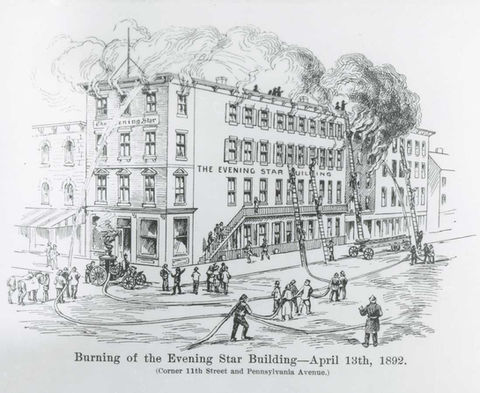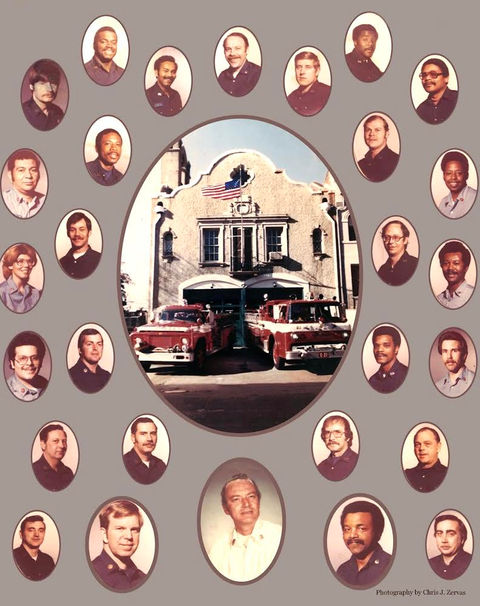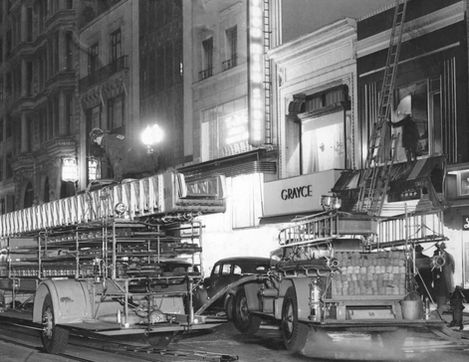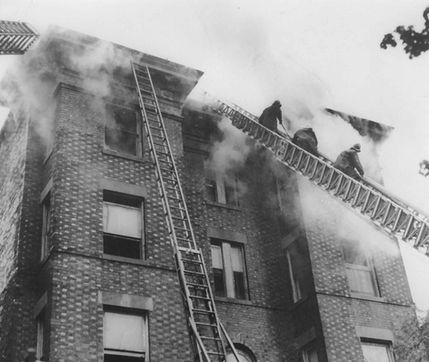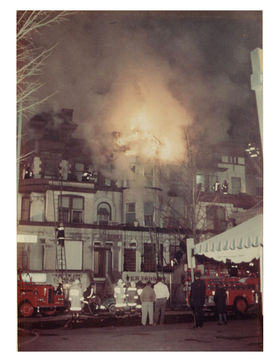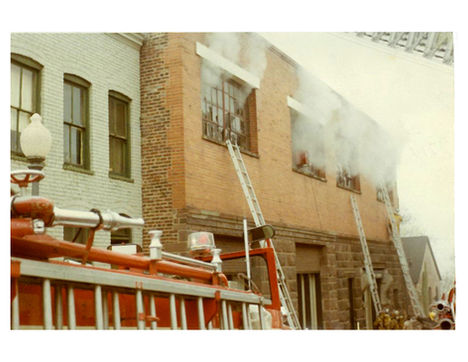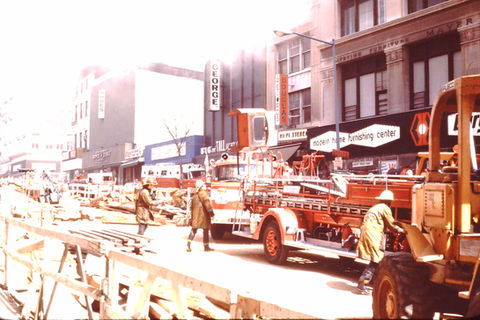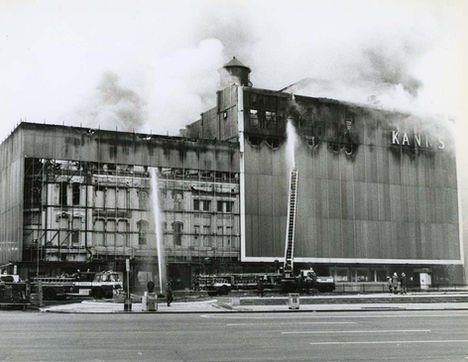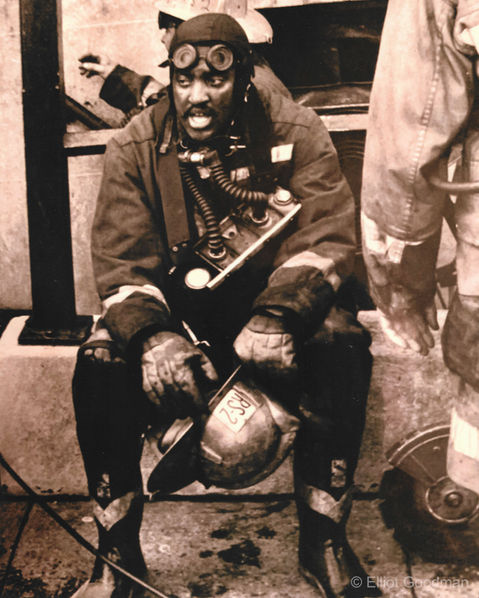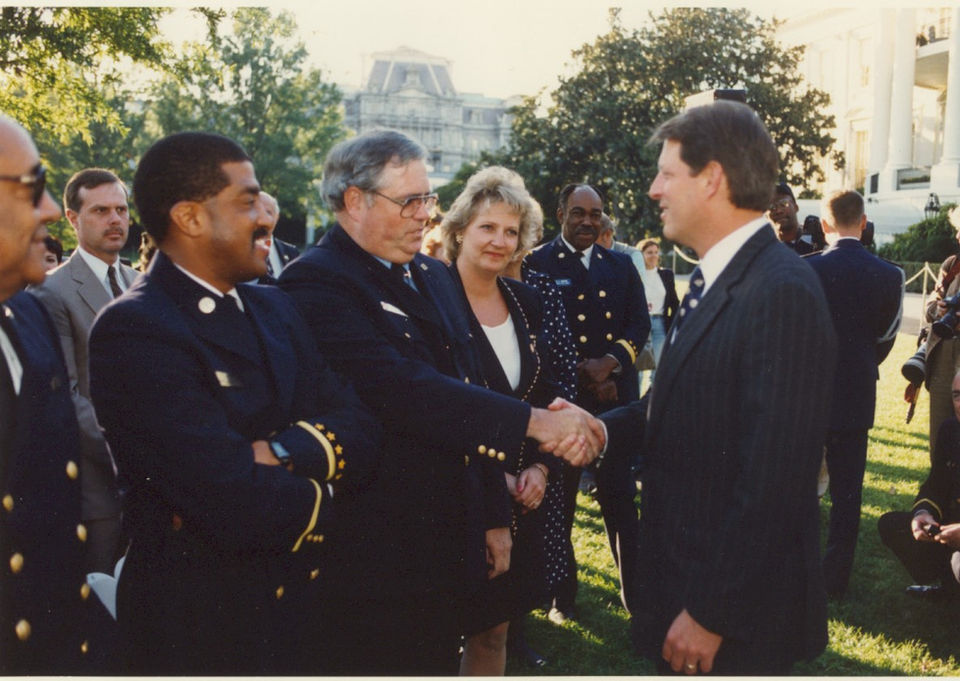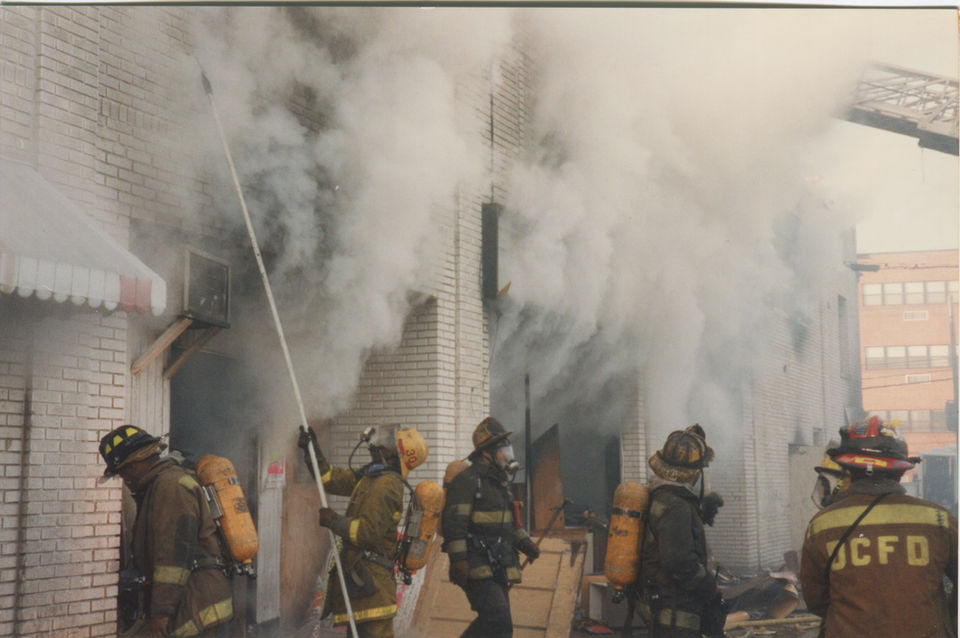
Fires by Decade
This page includes photos, videos, and oral histories by decade. Starting with the 1980s, the predominate story-telling medium is through videos of DC fires.
These images and videos demonstrate the evolution of the DC Fire Department’s fire suppression and rescue techniques over the course of its over 150-year history, as the field of fire science itself progressed and became more sophisticated. Throughout these same years, the Department’s apparatus and equipment improved, although there were periods of financial strain when operational resources and staffing were reduced. In the first half of the century, members fought fires without masks or radios, with non-fire-resistant uniforms, and with much heavier hose that would need to be hung up and dried after fires and then placed back to the apparatus. Until February 1992, the Department continued to use two-piece engine companies – one pumper and one wagon – staffed with five members. Ladder trucks were staffed by six members.
In 1925, heavy rescue squads were added to operations. These are giant toolboxes staffed by five personnel required to be proficient in a variety of specialized rescue disciplines, such as high-angle, collapse, below grade and swift water rescue, among others. At a fire scene, their primary duty is to search for victims. The Hazmat Unit, added in the 1980s, is staffed by five personnel and responds to incidents requiring specialized knowledge and tools to deal with chemical, biological, and radiological emergencies.
This 2001 video from Vito Maggiolo shows a Rescue Squad's technical below grade or "trench" rescue of a construction worker, from start to finish.
Four firefighters were burned, two of them critically, fighting this row house fire on Capitol Hill that extended into the neighboring house. Listen as Vito Maggiolo describes the scene.
Today, the one-piece engine is used and staffed by four members; ladder trucks are staffed by five. Every firefighter carries a radio and a device that emits a signal when the member has not moved for several seconds. There is a much more heightened awareness of the cancer-causing toxins present in modern smoke and fire, which has fueled not only the advancement of technology in protective clothing and other gear, but also led operations to be much more disciplined around when masks are donned and when they are removed on a fire ground. Similar discipline is required in determining how to approach a fire and whether to enter the structure to do interior firefighting, with a much higher emphasis today on preserving firefighter safety.
The fire and EMS services are now also talking more openly about the psychological and emotional strain of the job and working to effectively treat the incidence of post-traumatic stress disorder and other behavioral health challenges among first responders, which is higher than the general population.
While the number of structure fires today has reduced dramatically compared to the early and mid-20th century due to improved fire codes and enforcement, as well as the use of smoke alarms and sprinklers, they also burn much more quickly because of the prevalence of light weight construction and synthetic materials. Nonetheless, DC’s Bravest extinguishes fires just as quickly, if not more quickly, than in the past.
As you review this content, take note of these evolutions; know that the DC Fire and EMS Department is now better funded, equipped, and trained than ever before in its history. At the same time, immense pride around its history, traditions and strength remains.
1800s-1910s
The federal government moved to the newly selected Nation’s Capital, the City of Washington, in 1800. Throughout the 19th century, building owners in Washington were required to keep buckets in their homes in case of fire. Early rowhouses were marked by insignia that indicated which insurance or fire company protected the home. Prior to the establishment of the District of Columbia Fire Department in 1871, fires were fought by a combination of private and volunteer fire companies.
The following are the earliest photos or drawings of fires in the collection of the Washington, DC Fire and EMS Museum
The Mayhew Family
The Mayhew family has served the DC Fire Department for five generations, dating back to the late 19th century. Simon Aloysius McLane joined the Department first and took a train with other DC firefighters to fight the Great Baltimore Fire of 1905, an experience that would lead to his untimely death of phthisis a few months later. His son, Anthony LeGrande Mayhew, was appointed in 1923 and left the service early after losing his hearing in one ear during a fire in 1929. Anthony’s brother, Joseph A. Mayhew, served as the DC Fire Chief from 1949 to 1952. Anthony’s son, Donald McLane Mayhew, originally studied to be a chiropractor but then ultimately followed his father, uncle, and grandfather into the Department in 1959 and served for 20 years, with assignments at Trucks 13, 6, 4, and 2. He retired from Engine 21 at the rank of Captain. His son Donald Neil McLane was appointed in 1991, and also retired at the rank of Captain in 2020 from Truck 17. He worked during the challenging times in the 1990s when the Department’s staffing and apparatus budgets were cut due to the city’s financial downturn. He worked at Truck 4, Engines 6, 8, 14, and 31. Donald’s son, Matthew Kane Mayhew, was appointed in 2017 to Engine 10 and still works for the Department.
1920s
1930s
Source: Washington, DC Fire and EMS Museum
1940s
Source: Washington, DC Fire and EMS Museum
1950s
Source: Washington, DC Fire and EMS Museum
1960s
Source: Washington, DC Fire and EMS Museum
Robert Banasik
Robert Banasik was born in Youngstown, Ohio in 1939, where he grew up. As a young man, he had no plans to be a firefighter until his father-in-law shared an ad in the paper announcing an exam to join the DC Fire Department. Bob was a machinist apprentice and looking for work; he and his wife had celebrated their honeymoon in Washington, DC the year before. Bob took the exam and the rest was history.
He started his career with the Department in 1961 doing on-the-job training on his first day, hanging off a two-piece engine assigned to Engine 16 in downtown. He was at 16 Engine during the April 1968 riots that followed the assassination of Martin Luther King, Jr., and was at the tragic fire where Firefighter Tommy Turner died in 1971. He also spent time at Engine 1, Truck 15, Engine 29, and then as a Battalion Fire Chief in the 8th and 4th battalions. He retired in 1990.
Reflecting on his time with the Department, he said it was the most exciting this he’s done in his life, except for marrying his wife. When asked what he would like viewers of this website to know, he said, “I worked with some of the greatest people in the world. And they have to know that they've got one of the best - still one of the best departments the world.” You can hear more about his time with the Department here.
1968 Riots

Riots, April 4-6, 1968
1970s
Source: Washington, DC Fire and EMS Museum
Unless otherwise stated in photo caption



Footage by Sheldon Levy unless otherwise noted.
1980s
Source: Washington, DC Fire and EMS Museum



Footage by Sheldon Levy unless otherwise noted.
1990s
Donald Edwards
Donald Edwards was born in 1944 and raised in Washington, D.C., in the Parkview neighborhood. He attended Parkview Elementary School, Banneker Junior High School, and Theodore Roosevelt Senior High School. He attended Howard University and dropped out after a couple of semesters. He was drafted into the U.S. Army in 1966 during which he spent one year in the States and one year in Germany.
Edwards joined the DC Fire Department in April of 1969 and was assigned to Truck 10. As a private, he also spent one year in the Emergency Ambulance Bureau on Ambulance 4, as well as time at Engine 24, Rescue Squad 2, and as a Battalion Chief's aide. He was a Sergeant at the Fleet Maintenance Division and Truck 4; a Lieutenant at Engine 22, Truck 6, and Rescue Squad 1; a Captain as the Personnel Liaison Officer, at Engine 4, and at Rescue Squad 1; and Battalion Fire Chief in the 6th Battalion. Fire Chief Otis Latin appointed Edwards Deputy Fire Chief of Operations, a position he occupied when Mayor Marion Barry appointed him as Fire Chief in 1997. He served as Fire Chief for two years and two months during a very difficult time in the history of the city – the years it was overseen by a financial control board - as well as a difficult time for the Fire Department. During Chief Edwards tenure, four firefighters died in the line of duty after a period of 15 years with no line of duty deaths. Following his retirement, Edwards consulted in the private sector on fire prevention, fire suppression and emergency management.
Thomas Tippett served the DC Fire and EMS Department for 32 years before retiring at the rank of Interim Fire Chief in 2000 (he was never confirmed by the DC Council). Prior to entering the management ranks, he served as the President of Local 36 of the International Association of Fire Chiefs for many years. He resigned as Interim Fire Chief after the financial control board refused to reinstate funding for the fifth person on the ladder truck and battalion chief aides, cuts that were followed by the death of three firefighters in fires between 1997 and 1999. In his resignation letter, he said, "I have made a solemn promise to the firefighters of this city and to their families that I would do everything in my power to improve safety and not unnecessarily place my employees in harm's way. Therefore, I cannot in good faith carry out the directive."








Footage by Vito Maggiolo unless otherwise noted.

